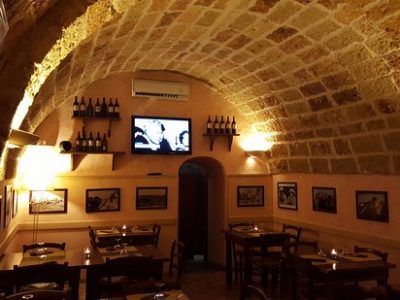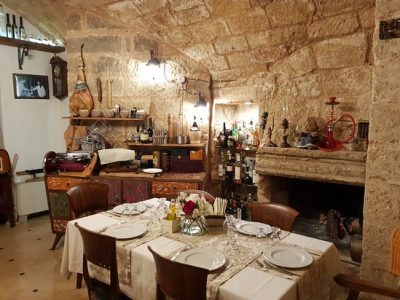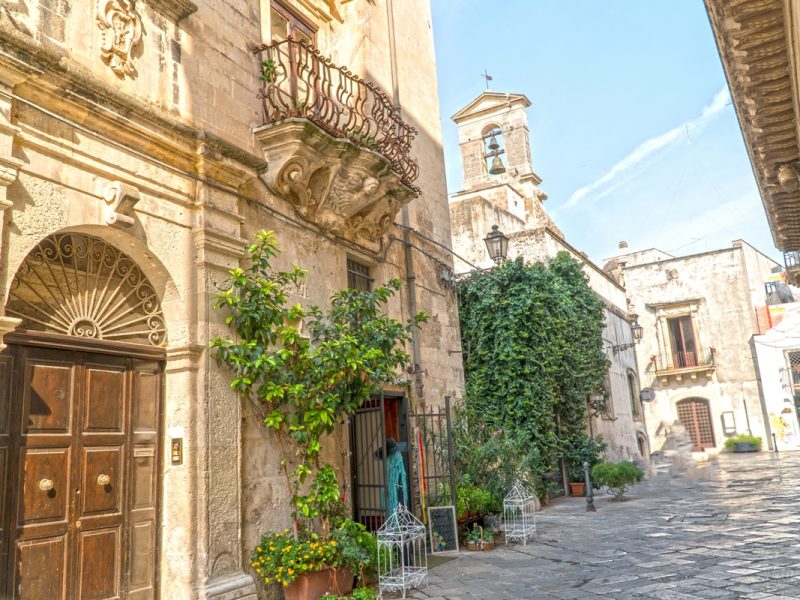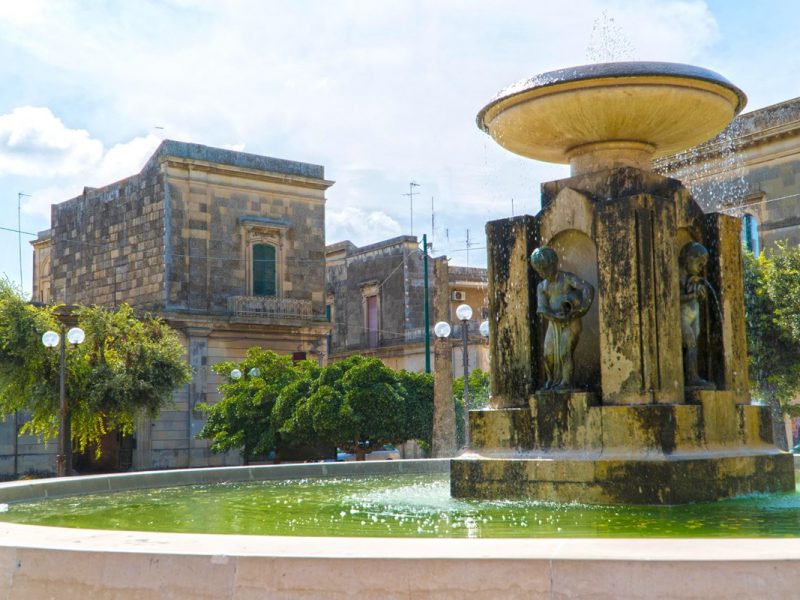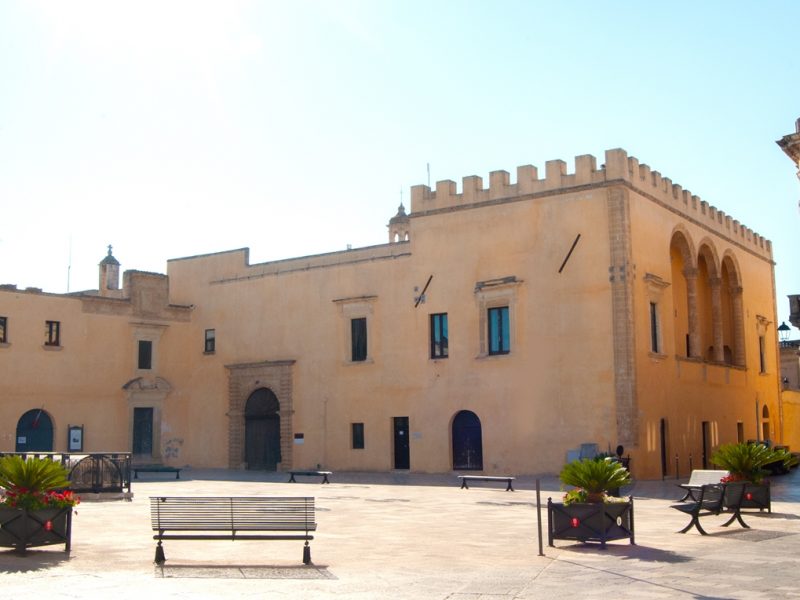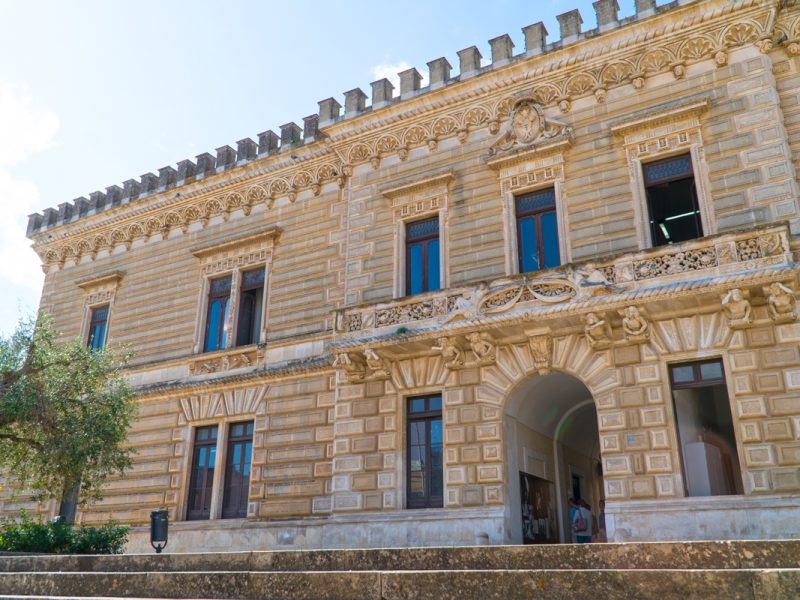The Borgo of Ugento
The soul of Ugento is like a sprightly old woman…it is difficult to guess her age, number of husbands, or the tragedies she has endured and survived. Her date of birth has been lost in the annals of time. The ancient stone artifacts, called Menhirs and Dolmens, found in her territory, represent pieces of an ancient, pre-historic puzzle, but Ugento’s essence and primary identity remains Messapian, her most wealthy and powerful incarnation. She then became Roman, then Norman, and then a fief of the Swabian dynasty. Over the centuries, she has known the brutality of being invaded and sacked countless times, but nevertheless she has maintained a lively and playful spirit. It is surely the crystalline sea of her marinas, and the fascination of being a “City of Art” that keeps her expression smiling and youthful.
Ugento is a city of eternal beauty, and instead of hiding the wrinkles of her past, she exalts and displays them with pride. She is a phoenix rising from the ruins of her ancient walls, gazing down from the heights of her castle upon the Crypt of the Crucifixion, upon her magnificent Cathedral, smiling down upon her jewel of an annex, the little town of nearby Gemini.
GEMINI
Gemini is the Latin word for twins, and this is the probable etymological origin of little hamlet of Ugento. It’s foundation, in fact, is linked to an ancient legend about the god Zeus and his twin sons. Zeus was in love with Leda, the Queen of Sparta, and one day, while she was resting beside a lake, the father of the Gods decided to transform himself into a swan so he could observe her more closely. She was so beautiful that he couldn’t resist her and he united with her. From their union, she gave birth to twin sons: Castor and Polydeuces, the “Dioscuri”(dark gods). Of the two, only Castor was mortal, and when he was killed in battle, Polydeuces, out of love for his brother, requested to be sent the Underworld to join him. Zeus, deeply moved by their bond, asked Polydeuces to renounce half of his immortality and decreed that the two of them would alternate living in two worlds, one day in Olympus, and one day in Hades, the Kingdom of Death. The “Dioscuri” were beneficent gods, who guided and rescued sailors during storms at sea. The two sons of Zeus were deeply venerated in Gemini, which is probably the reason for the name of this little hamlet of Ugento.
The traces of its Roman past go through the center of town, around the periphery and surrounding countryside, leading us back through time until we reach its foundation.
In the past, Gemini served as a support system for Ugento, the younger sister who became powerful in times of need. The walls of this little village gave refuge to the bishops and the townspeople of Ugento when they needed to escape from invading barbarians or Ottoman Turks (Saraceni), and in gratitude for this hospitality, the survivors of the invasions built regal palaces and noble homes, which still remain today, testimony of this fraternal union.
Today, Gemini is an annex of Ugento, profiting from the reflection of the abundant tourism in the summer season, and during the year, offering a peaceful, friendly place to live. The main event of this little village is at Christmas time, when the citizens create a living Nativity scene, the “Presepe Vivente”, a theatrical re-animation of the manger scene..with the citizens playing the part of all the biblical characters, transporting visitors back in time with such realism that people come from all over Salento for this magical event.
History
The history of Ugento borders on the mythological. Clues and traces of the city’s past continue to emerge from the archeological sites of modern day Ugento, but many pieces of the puzzle still remain to be found before the picture of her true origins can be completed. The megaliths peppering her territory bear witness to pre-historic communities, while the local coins displayed in the Civic Museum give testimony of a proud City-State with its own mint, producing its own currency. In Messapian times, Ugento was called Ozan, and was so powerful that it was in competition with Taranto, which, in turn, boasted a prowess eventually incurring the envy of Rome itself. Ozan based the foundation of its wealth on the sea. The first ports were constructed, strengthening the reach of its navigation, trade-routes and commerce. Intense trading with Taranto brought the fruits of the Magna Grecia to Ugento. The renowned statue of Zeus, discovered in the city, originates from this era, and is a source of great pride.
The Roman conquest of Ugento heralded a period of decline. Uxentum, as it was now called, never quite metabolized the influence of the “Great” Roman Empire. During this period it was subject to invasion and sacking by the hostile Ottoman Empire, (the Saraceni), who completely destroyed the city. Those who managed to survive began to rebuild, and from the ruins of the monuments and the destroyed city walls they constructed new homes.
With the arrival of the Normans, Ugento raised her head once more, and from the ruins of the Roman Castro (Central Fort), a magnificent castle was constructed to defend the city from invaders. This encouraged the citizens who had escaped to nearby Gemini to return, thus increasing the population.
Ugento was able to reorganize the life of her civilians, and spent the Medieval period under the rule of various feudal lords: the D’Acquisto who levered the population with heavy taxes, and the D’Amore, who showered the city with pomp and splendour.
Today, Ugento’s extensive biography is written in the streets of her historical center, nobly demonstrating and preserving all she has inherited throughout the course of her challenging history.
The Cathedral
In 1880, Ugento destroyed part of the center to make space for what is now Piazza San Vincenzo.
The square is dominated by the majestic Cathedral, built in the 1700’s, hosting one of the most ancient practicing churches in the south of Italy.
The facade of the Cathedral is in neo-classical style, with columns in the Greek style, as desired by the bishop at the time of construction. Unfortunate interventions later brought a dark period to the Cathedral, which for a time had its entire interior covered in grey paint.
Today, thanks to recent restorations, the church has been returned to its original splendor. Upon entering the lateral doors, you are met with an explosion of color. The Baroque altars have been restored to their lively and authentic tones, and the entire Cathedral glows with light and harmony.
The Castle
From its lofty perch, the Castle D’ Amore dominates the entire Borgo and welcomes guests who arrive from the north-west. Its strategic position is not by chance. The Normans had it constructed over the ruins of the Roman Castro/Fort because the location facilitated the ability to control the entrance of new arrivals to the town. The Castle of Ugento originated from the necessity of defense, evident in its imposing form and the rigid, linear quality it has maintained over the centuries.
The Marquis D’Amore softened its austerity by adorning it with decorated window frames and other elegant decorations, enlarging the internal spaces and making it more luxurious by adding fascinating paintings in a mythological theme.
The Crypt of the Crucifix
The Crypt of the Crucifix, which probably dates back to the Messapian period, is situated just outside the town, on the road to Melissano. It is undoubtedly the most controversial of Ugento’s historical sites, continuing to fascinate and divide historians.
The volt is covered in frescos, in itself not unusual, except that the frescos depict esoteric images and symbols of persecution, linked to events in the Roman Empire. Fantastic animals populate the volt of this crypt, entwined in flowers, fruit, eight-pointed-stars and shields with red and black Templar crosses, invoking the Knights of Templar.
Today, the Crypt of the Crucifix remains a mystery, continually inspiring new hypotheses in the archeological and historical communities.
Museums
In Ugento, every time some construction work has to be done, a new archeological discovery is unearthed. The millennial history of this town speaks to us through the ancient relics discovered here over the centuries. The most important collector of historical relics was Baron Adolfo Colosso, the most illustrious citizen of Ugento, who, between 1800 and 1900, gathered some 794 items of antiquity found in the territory of Ugento, to which have been added other relics from more recent times. The “Colosso” collection is one of the most prestigious in Salento, and today, after years of careful preservation, it can now be visited in the Adolfo Colosso Museum in the Colosso Baronial Palace.
The Civic Museum is found nearby, in the ex-monastery of the Franciscan monks, the “Frati Minori Osservanti”, and is one of the most important buildings in the historical centre. The building itself has a long history. The monks lived there until the middle of the 1800’s, when it became the property of the State and, therefore, the municipality. In the 1960’s, Ugento felt the necessity to gather all archeological findings in a central place, and where better than the monastery.
Today the Civic Museum is home to important historical pieces, such as the ancient coins of Ozan, testament to its ancient mint, and an exact replica of the bronze statue of Zeus, which was found in Ugento and is the symbol of the city.
Testament to the spirituality of the city can be found in the Church Museum of the Diocese. The subterranean vaults under the Cathedral of Ugento host gold chalices, ancient prayer books and statues in papier-machè, paintings, ceramics and fabrics, creating a mystical environment of spirituality.
The Statue of Zeus
It would be hard to imagine the faces of the construction workers, intent on digging a new foundation for a home, when they came upon the ancient statue of a Greek god. Did they realize they had made the most important discovery in the history of Ugento? Zeus had been resting for thousands of years under the city, protected by a mass of stone that was part of its original altar. It is extremely rare to discover a bronze statue dating back to 500 B.C., especially in such an optimal state of conservation.
This Zeus is a proud deity, his stance moving forward towards his devotees, with a staff in one hand and an eagle in the other. His proud stance corresponds perfectly to the importance of the statue in relation to Ugento, in fact this Zeus is considered its very symbol…a reminder of Ugento’s origins as a rich and powerful capital conducting trade with the Spartan city of Taranto.
The original statue is now lovingly conserved in the museum of Taranto, while its replica can be admired in the Civic Museum of Ugento.
Le Secche, the Reefs
The reefs of Ugento extend for almost four kilometers, just below the water line, between Torre Pali and Torre Mozza, creating an invisible line of jagged underwater teeth, that for centuries have caused innumerable shipwrecks, some of great fame: Prious, for example, became trapped there as he rushed to provide military support to a Taranto under siege, and the shipwreck of the merchant craft Liesen, which even today lies at the bottom of the sea, has become a tourist destination for curious divers.
Among the reefs, just above the surface of the water, are three famous rocks: Cavallo (horse), Puledro (colt), and Giumenca (mare), unusual names that hearken back to Ottoman invaders and a legend.
It is said that the Saraceni, or Ottoman, pirates, after sacking Castrignano del Capo and other nearby towns, were returning to their ship loaded with treasure, when they encountered an elderly farmer and his three horses. Unable to resist such easy prey, they captured him as well, imprisoning him and his horses below deck with the rest of their loot. As their pirating had been lucrative and plentiful, they began to celebrate, in their euphoria drinking all the wine they had stolen. Soon in a drunken stupor, they were too drunk to realize that a terrible storm was almost upon them. When it hit, they were too busy trying to save themselves to bother with the prisoner trapped below deck, dooming the poor farmer and his horses to a certain death…until the violent motion of the boat snapped the farmers chains and he rushed above deck, gripping the mast for dear life. He remained there all night, as the boat was being driven by the currents towards the treacherous waters of Le Secche, the sharp stone reefs.
None of the pirates survived the storm, but at dawn, local fishermen discovered the farmer, safe and sound, still gripping the mast, with his three horses, all alive and well, each of them standing on their own rock in the middle of the sea.
“Ugento, without Faith, without Sacrament”
This famous saying about Ugento goes back to the beginning of the 1700’s. The Cathedral of Ugento had just been built, but not yet inaugurated for worship. The Bishop, a surly and contentious man, had commissioned a bell for the new church, a marvelous bell, with a sweet and melodious tone.
Even though the Bishop continued to request the inauguration of the Cathedral, for one reason or another it continued to be postponed, and the wonderful bell remained silent and covered in dust. The Bishop finally lost his patience, and in a fit of pique, donated the bell to the Cathedral of Altamura, which in the meantime had been inaugurated.
For Ugento, this was an intolerable insult, and the citizens and the members of the church took a united stance against the Bishop, undermining his authority in any way they could, until he finally gave up in frustration and abandoned his role as Bishop of Ugento, getting into his carriage to go as far away as possible. When he arrived at the Sanctuary of the Madonna of Light just outside the city, he got out and dusted off his shoes to eliminate any trace of the town which had turned against him, declaring with deep resentment, “Ugento, without Faith, without Sacrament!”
Do you know of any famous people related to this borgo? Contact us!
“Ciciri" and “Tria"
Ciciri and Tria is one of the oldest recipes in the Salentine gastronomic tradition. Already mentioned by the Latin poet Orazio, who praised this soup consisting of chickpeas, leek and lasagne, this type of pasta is found throughout in Salento with the name of “Tria", derived from the Arabic word “itriyah" (dry pasta).
This simple but very tasty dish is prepared throughout the year. The main ingredient is chickpeas. “Tria" pasta is prepared with wheat and water bran, everything is flavored with a part of the pasta that is fried: “frizzuli" in extra-virgin olive oil.
If you do not have time to prepare pasta at home, you can buy fresh tagliatelle or use similarly shaped dry pasta.
The ingredients:
300 gr. of dried chickpeas
1 teaspoon of bicarbonate
coarse salt (about two handfuls)
hot pepper or pepper
salt
1 onion
4 bay leaves
extra virgin olive oil
for the “Tria":
500 gr of flour (durum wheat semolina)
1 teaspoon of salt
water q.b.
Preparation of chickpeas
Take the dried chickpeas and pour into a container, add a teaspoon of bicarbonate, a handful of coarse salt, pour a little water and mix them with your hands. Cover with plenty of water and let them soak overnight (at least 12h). The next morning remove the water, wash and pour the chickpeas in a pot, cover completely with fresh water and start cooking. In a saucepan, keeping it continually over the flame, pour a handful of coarse salt together with the water that will be used for cooking. When the chickpeas boil, remove the water, which will be foamy, and add the hot water from the saucepan. Add a white onion cut into pieces and three bay leaves to the pot. Cook for about 1h, taking care to always keep the chickpeas well covered with water. Adding hot water, if necessary.
Preparation of “Tria" fresh pasta.
Pour the flour on a work surface, form a mound and pour water into the center, along with a teaspoon of salt. Start to knead. Adding more water if necessary, the dough should be soft and smooth. Work the dough until it is elastic. With rotary movements of the hand, form a ball. Now your dough shoud be soft and smooth. Sprinkle it with some flour and leave it to rest for at least 1h. Begin to roll out the dough with a rolling pin. Roll out the dough to form a circle that is not too thin. Start to fold the dough on itself, sprinkle with plenty of flour before each step to prevent the various layers from sticking together. Cut the ends of the dough to form a rectangle. With a pasta cutter or a knife, cut the fettuccine, a few mm wide. As soon as this operation is done, immediately unfold the dough and sprinkle with flour to keep it from drying out. Place it on the work surface and let it dry for a couple of hours. Remember to put aside the pasta, the cuttings and the smaller fettuccine to be fried (about a handful is plenty). Take the cooked chickpeas, remove the onion and leave a little of the cooking broth.
Preparation of “frizzuli" fried dough
In a saucepan pour extra virgin olive oil, heat it with two chili peppers (the amount of peppers should be based on how spicy you want the recipe). Pour into the oil the dough and put aside along with a bay leaf.
Fry it until golden, and here are the “frizzuli". Meanwhile, prepare a pot of water and salt. Turn on the stove and bring to a boil, pour the tagliatelle and cook for a few minutes. When you see them emerge on the surface, remove from the fire. Remove the cooking water, leave just a little on the bottom of the pot. Return to the stove on low heat. Pour the chickpeas and their cooking broth, stir. Add also the fried “frizzuli" pasta with all the oil and mix well so as to flavor all the pasta. If you have not flavored the oil with chili peppers, you can sprinkle lightly with freshly ground pepper. When the pasta starts to stick to the bottom of the pot, turn it off.
Put into a pasta dishes and serve.

 Italiano
Italiano
 Deutsch
Deutsch













